
Customers seeking an electric pickup truck currently have
plenty of options to choose from
, but all of those current options share a few things in common. Each one is expensive, with even the cheapest electric truck, the Ford F-150 Lightning, costing around $50,000 in base-spec form. They’re all also physically big trucks, having been designed to rival full-sized ICE pickups in both appearance and capabilities. At present, there are no affordably priced, compact electric pickups on the market to compete against the likes of the Ford Maverick and Hyundai Santa Cruz, although that might change soon.
Slate and Telo, two competing electric vehicle start-ups, are aiming to capture a piece of the niche pickup truck market with their first vehicles. Slate’s inaugural model is set to make an entrance.
unimaginatively named Slate Truck
, is set to be the cheaper of the two, with a planned starting price of around $27,500. With the federal EV tax credit, that price drops down to around $20,000. Telo’s MT1, meanwhile, is set to start from $41,520, or $34,020 including federal EV tax credit.
Read more:
10 Of The Most Reliable Toyota Engines Ever Built, Ranked
The Telo MT1 Boasts Unmatched Reach and Strength

While the Slate truck’s low starting price might make it attractive for buyers on a budget, it also comes with compromises. With a standard battery, the truck offers a provisionally estimated 150 miles of range, while its extended battery brings that range figure up to 240 miles. Opting for the extended battery will increase the truck’s starting price by around $5,000. In comparison, the Telo MT1’s standard battery should be able to travel 260 miles between charges according to the brand, and its optional $3,980 long range battery should hit 350 miles of range.
The MT1 also packs more power, with 300 horsepower available in single motor guise and 500 horsepower on offer with the optional dual motor. All Slate trucks make do with a 201 horsepower single motor. Towing capacity also differs hugely between the two, with the Slate able to tow up to 1,000 pounds and the Telo aiming to offer a maximum towing capacity in excess of 6,000 pounds. The story is similar for each truck’s payload capacity: the Slate’s 1,400 pound capacity is notably less than the 2,000 pounds on offer with the single motor MT1.
Is Any of These Trucks Going to Make It to the Market?

All of these specs are, for now, provisional figures that don’t mean much unless both trucks can make it out of the development cycle and into the hands of customers. It’s far from guaranteed that either will reach production, and even if they do, that’s only step one. Step two is figuring out how to make each truck profitable, which
will be particularly difficult for Slate
given its lowing starting price.
The company seems to be banking on high production volumes and better margins from the truck’s personalization program, which includes accessories to turn the truck into a mini SUV and add lift kits and off-road tires, among many other things. Still, with the company backed by Amazon founder Jeff Bezos, Slate should benefit from plenty of startup funding to keep it running while it tries to reach profitability.
Telo doesn’t count one of the world’s richest men among its backers, but it has previously claimed to have already secured enough funding to scale production up to around 5,000 units a year, where it should start to make a profit. However, its unusual looks and much higher starting price mean that its success is far from assured either.
Want the latest in tech and auto trends?
Subscribe to our free newsletter
for the latest headlines, expert guides, and how-to tips, one email at a time.
Read the
original article on Dailyexe
.






